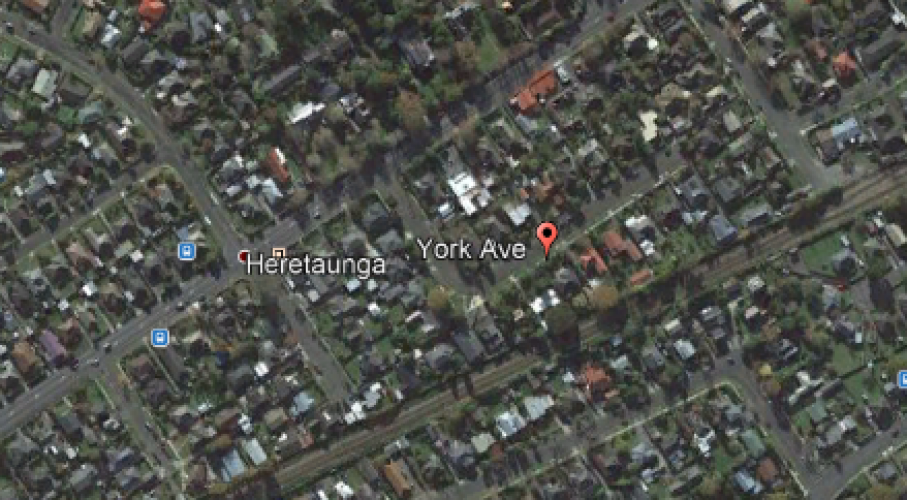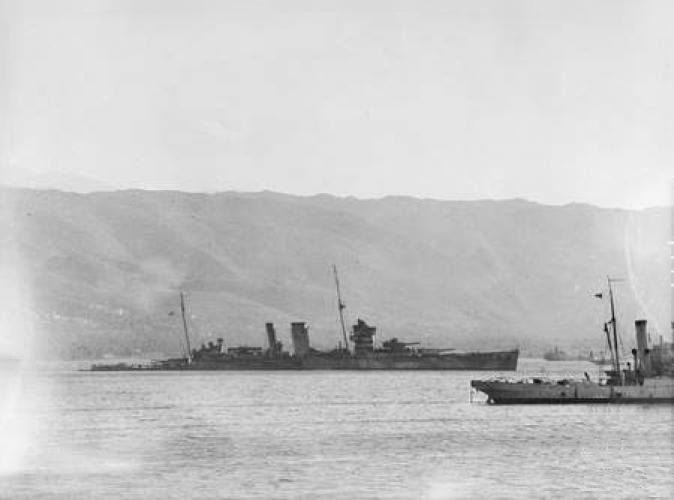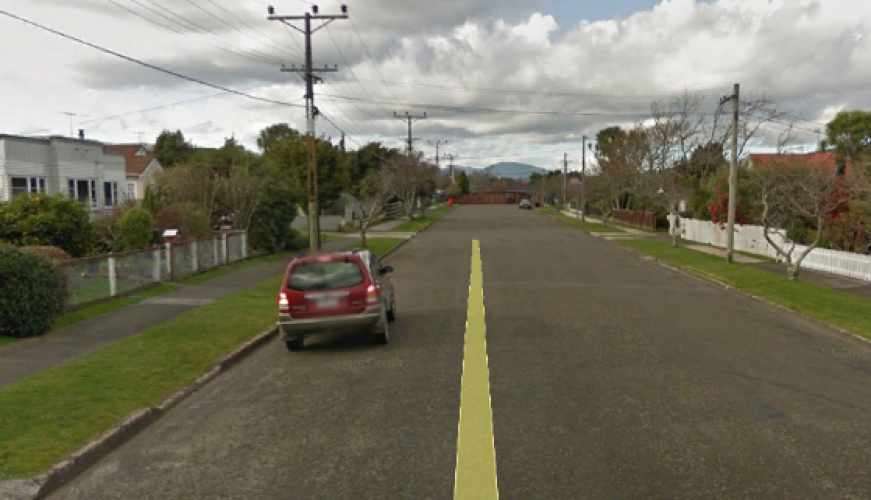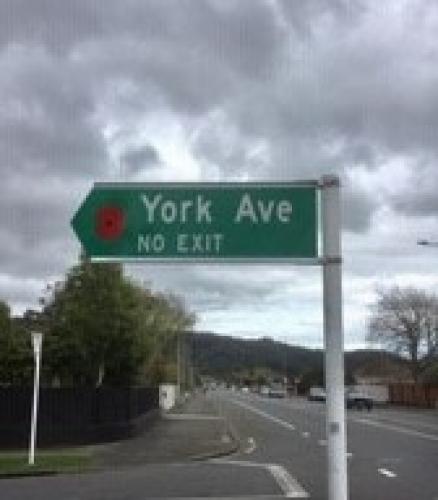210 York Avenue Heretaunga Upper Hutt, street scene 2018
Reason for the name
York Avenue was named after HMS York.
HMS York (90) was the first of two York-class heavy cruisers built for the Royal Navy in the late 1920s. She served in WWII and was wrecked in an attack by Italian explosive motorboats at Suda Bay Crete in March 1941.
New Zealand Army units played a major part in the battle of Crete.
HMS York was salvaged in 1952 then scrapped in Bari.
HMS York, HMS Elizabeth and HMS Hood were all Royal Navy ships. York, Elizabeth and Hood streets are next to each other and all come off Ferguson Drive. York Avenue was not named after the Duke and Duchess of York who visited New Zealand in 1927. Around 1960s Aorangi Street was merged into the end of York Avenue and then renamed York Avenue. York Street was recorded in the Wises NZ Post Office Directory 1955 & 1959 & 1961-1962 volumes.
She mostly served on the North America and West Indies Station before World War II. Early in the war the ship escorted convoys in the Atlantic and participated in the Norwegian Campaign in 1940. York was transferred to the Mediterranean theatre in late 1940 where she escorted convoys and the larger ships of the Mediterranean Fleet. She was wrecked in an attack by Italian explosive motorboats of the 10th Flotilla MAS at Suda Bay, Crete in March 1941. The ship's wreck was salvaged in 1952 and scrapped in Bari.
Author: The Poppy Places Trust
York was laid down by Palmers Shipbuilding and Iron Company, Jarrow, on 18 May 1927, launched on 17 July 1928 and was completed on 1 May 1930. She became the flagship of the 2nd Cruiser Squadron of the Home Fleet upon commissioning. Between 1931 and 1934 she was commanded by Captain Richard Bevan. She served with the 8th Cruiser Squadron on the North America and West Indies Station, and was detached to the Mediterranean Fleet in 1935 and 1936 for the Second Italo-Abyssinian War, before returning to the American Station until the outbreak of war in September 1939.
The ship was transferred to Halifax, Nova Scotia that same month for convoy escort duties. In October 1939, York was assigned to Force F at Halifax, which was active in hunting for commerce raiders and protecting convoys. She was briefly refitted in Bermuda between 31 October and 22 November before she returned to Great Britain for a more thorough refit in December. Upon its completion on 9 February York was assigned to the 1st Cruiser Squadron of Home Fleet. On 3 March 1940 the ship intercepted the German blockade runner Arucas in the Denmark Strait near Iceland, but she was scuttled by her own crew before she could be captured.
In early April 1940, York, and the rest of her squadron, were assigned to carry troops under Plan R 4, the British plan to invade Norway. The troops were disembarked on 8 April when the British learned of the imminent German invasion of Norway and the squadron, under the command of Vice-Admiral John Cunningham, joined the bulk of the Home Fleet already at sea. On 10 April the destroyer HMS Eclipse was badly damaged by air attack and York was detailed to tow her to Lerwick for repairs. The ship, and the light cruisers HMS Manchester and HMS Birmingham, ferried the 1st Battalion of the Green Howards and other troops from Rosyth to Åndalsnes and Molde on 24–25 April. York returned home on 26 April. York was one of the ships used to evacuate British and French troops from Namsos, along with three French transports and a number of British destroyers, on the evening of 1/2 May.
In August 1940 York was assigned to the Mediterranean Fleet, joining the 3rd Cruiser Squadron in Alexandria in late September, after escorting a convoy around the Cape of Good Hope. Two days later she participated in Operation MB.5, where the Mediterranean Fleet escorted the light cruisers HMS Liverpool and HMS Gloucester as they ferried troops to Malta. During the Battle of Cape Passero, York sank the disabled and abandoned destroyer Artigliere on 13 October after the destroyer's engagement with the light cruiser HMS Ajax the previous evening. A month later York and the Mediterranean Fleet executed Operation MB8, a complex series of manoeuvers, including Operation Judgement, where the ship escorted the aircraft carrier HMS Illustrious as her aircraft attacked the Italian Fleet at Taranto on the evening of 11/12 November. A few days later York ferried British troops from Alexandria, Egypt to Piraeus, Greece. On 26 November, York, and the rest of the 3rd Cruiser Squadron, covered a small convoy to Malta.
The Mediterranean Fleet, including York, sortied on 16 December to conduct air strikes on Italian shipping, airbases on Rhodes and to bombard Valona. In early January 1941 the ship escorted the tanker RFA Brambleleaf and four Flower-class corvettes to Suda Bay, Crete and covered operations in the Eastern Mediterranean during Operation Excess. She arrived back at Alexandria on 16 January. York returned to Suda Bay in early February for operations against Italian shipping. During Operation Lustre in March, she protected troop convoys from Egypt to Greece.
York was disabled at Suda Bay in Crete by two Italian explosive motorboats of the Italian Regia Marina assault Flotilla Decima Flottiglia MAS, launched by the destroyers Crispi and Sella on 26 March 1941; the two old destroyers were fitted with special cranes to operate assault craft. Six motorboats entered the bay, led by Tenente di vascello Luigi Faggioni, and attacked three targets in pairs; the first was York, second the tanker Pericles and last another ship at anchor. Three of the attacking boats had various problems, either mechanical or human, due to the extreme temperature conditions, but the other three successfully attacked their targets. Two motorboats, packed with 330-kilogram (730 lb) charges in the bows, struck York amidships, flooding both boiler rooms and one engine room. Two British seamen were killed. All Italian sailors survived the attack and fell into British hands. The ship was run aground to prevent her from sinking. The submarine HMS Rover was used to supply electrical power to operate the cruiser's guns for anti-aircraft defence, until Rover was severely damaged by air attack and had to be towed away for repairs. On 18 May, further damage was inflicted by German bombers and the ship was damaged beyond repair. Her main guns were wrecked by demolition charges on 22 May 1941 when the Allies began to evacuate Crete. York's wreck was salvaged in February 1952 by an Italian shipbreaker and towed to Bari to be broken up, beginning on 3 March.











